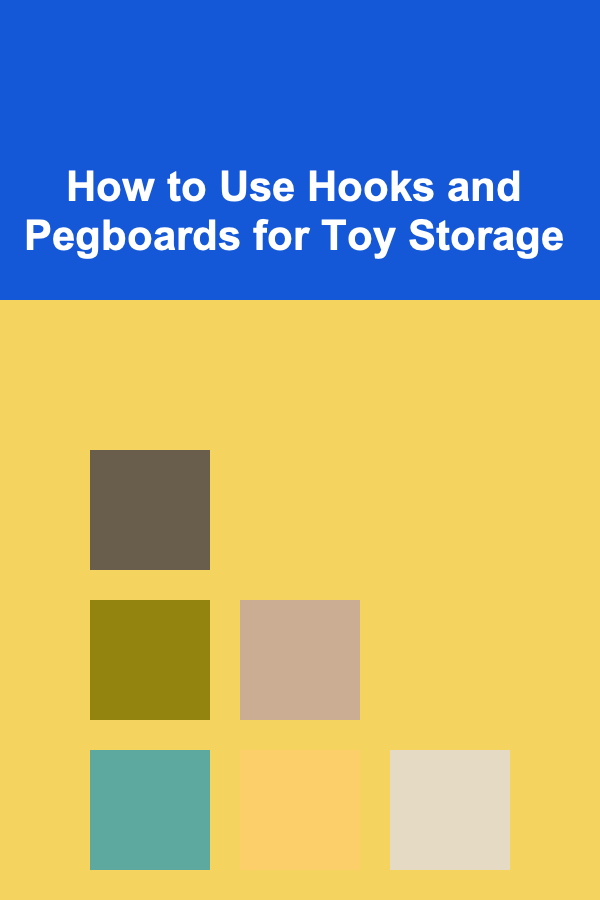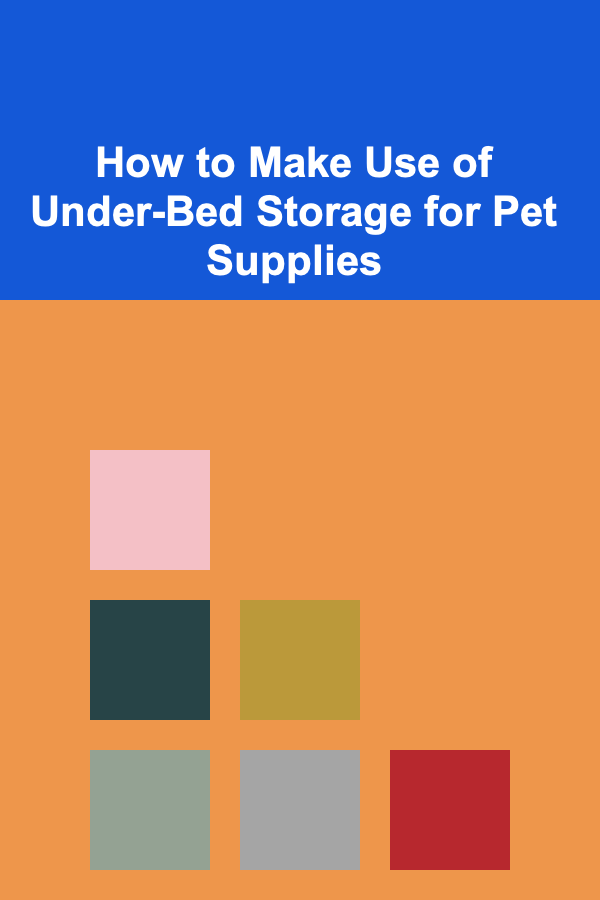
How to Use Hooks and Pegboards for Toy Storage
ebook include PDF & Audio bundle (Micro Guide)
$12.99$11.99
Limited Time Offer! Order within the next:

Organizing toys can often feel overwhelming for parents and caregivers. As children grow, their toys accumulate, leading to cluttered spaces that can stifle creativity and make playtime less enjoyable. However, utilizing hooks and pegboards as storage solutions can transform chaotic areas into organized, functional spaces. This article will explore the benefits of using hooks and pegboards for toy storage, practical tips for implementation, and creative ideas to inspire your organization journey.
Understanding the Benefits of Hooks and Pegboards
1. Maximizing Vertical Space
One of the main advantages of using hooks and pegboards is their ability to maximize vertical space. Walls and corners often go underutilized in play areas. By installing pegboards, you can free up floor space while keeping toys accessible.
2. Encouraging Independence and Responsibility
When toys are organized and easily accessible, children can take ownership of their belongings. This independence encourages them to clean up after playtime, fostering a sense of responsibility and ownership over their toys.
3. Versatility and Customization
Hooks and pegboards come in various sizes, shapes, and colors, allowing customization to fit any room's aesthetic. You can adapt the setup as your child's interests and toy collections change, making it a long-term solution.
4. Easy Maintenance and Visibility
With toys hung on hooks or organized on pegboards, it's easy to see what is available for play. This visibility helps children choose toys independently and simplifies the cleanup process.
5. Promoting Creativity
An organized play space encourages creativity. When children can see their toys, they are more likely to engage with them and explore new ways to play, enhancing their imaginative skills.
Choosing the Right Location
1. Assess the Play Area
Before installation, assess your child's play area. Identify the best wall space or corner that can accommodate a pegboard without interfering with other activities.
2. Consider Accessibility
Ensure that the location is within your child's reach. Hooks and pegboards should be low enough for them to access their toys independently, promoting autonomy.
3. Evaluate Safety Concerns
Safety should always be a priority. Avoid placing pegboards near heavy furniture or sharp edges, and ensure that all installations are securely anchored to prevent accidents.
4. Use Multiple Locations
If space allows, consider multiple pegboard stations throughout your home. For example, you might have one in the playroom and another in a bedroom, allowing for easy access to toys in different areas.
Selecting the Right Hooks and Pegboards
1. Material Choices
Pegboards are typically made from wood or metal. Wooden boards provide a natural aesthetic, while metal boards offer durability and a modern look. Choose the material based on your design preferences and the weight of the toys you plan to hang.
2. Size Matters
Select a pegboard size that fits your space. Larger boards can hold more items, but smaller boards can be used for specific categories of toys, such as art supplies or building blocks.
3. Choosing Hooks
Hooks come in various styles and sizes. Consider the types of toys you'll be hanging. For instance:
- Large hooks for heavier items like stuffed animals.
- Smaller hooks for lightweight toys like action figures or cars.
- Specialty hooks designed for specific items, such as backpacks or sports equipment.
4. Color and Finish
Choose colors that complement your child's room decor. Bright colors can add a playful touch, while neutral tones can create a more streamlined look.
Creative Ways to Organize Toys
1. Themed Zones
Create themed zones on your pegboard. For example, designate one area for art supplies and another for building toys. This method helps children locate their desired items quickly and encourages themed play.
2. Use Baskets and Containers
Incorporate small baskets or containers on hooks to hold smaller items. This keeps tiny toys grouped together and prevents them from falling off the board.
3. Rotating Displays
For seasonal or thematic toys, consider rotating displays. This not only keeps things fresh but also gives your child something new to engage with regularly.
4. Hang Costumes and Dress-Up Clothes
If your child loves dressing up, utilize hooks to hang costumes and accessories. This makes them easily accessible for play while keeping them organized.
5. Utilize Clear Bags for Smaller Items
For small toys that can easily get lost, consider using clear resealable bags attached to hooks. This keeps items visible and organized while preventing clutter.
Incorporating Labels for Easy Identification
1. Label Everything
Labeling is essential for helping children identify where toys belong. Use easy-to-read labels with words and pictures, especially for younger children who are still learning to read.
2. Create a Color-Coded System
Implement a color-coded labeling system. For example, use red labels for art supplies, blue for building toys, and green for dress-up items. This visual cue makes it easier for children to remember where each item goes.
3. Interactive Labels
Consider creating interactive labels that your child can help design. This involvement can enhance their investment in the organization system and encourage them to maintain it.
4. Use Removable Labels
Using removable labels allows you to change categories as your child's interests evolve. This flexibility ensures the organization system remains relevant over time.
Maintaining the Organization System
1. Set Cleanup Routines
Establish daily or weekly cleanup routines that involve your child putting toys back onto the pegboard. This practice reinforces ownership and responsibility.
2. Regularly Assess the System
Every few months, reassess the organization system. Remove toys that are no longer played with and adjust the layout as necessary. This keeps the space functional and current.
3. Involve Your Child
Encourage your child to participate in the maintenance process. They can help decide which toys to keep and which to donate, fostering critical decision-making skills.
4. Celebrate Achievements
Celebrate when your child successfully maintains the organization system. Positive reinforcement can enhance their motivation to keep the area tidy.
Conclusion
Using hooks and pegboards for toy storage is an effective way to create an organized, functional play area. By maximizing vertical space, encouraging independence, and promoting creativity, these systems enhance both playtime and cleanup efforts.
Implementing hooks and pegboards requires thoughtful planning, from selecting the right location and materials to organizing toys creatively and maintaining the system. By engaging your child in the process, you not only empower them to take responsibility for their belongings but also foster valuable organizational skills that will benefit them throughout life.
With these strategies, you can transform cluttered spaces into inviting, organized environments that inspire creativity and play. Embrace this opportunity to make toy storage a rewarding experience for both you and your child.
Reading More From Our Other Websites
- [Home Maintenance 101] How to Prevent and Maintain Your Home's Flooring for Durability
- [Organization Tip 101] How to Choose the Best Drywall Patch Repair Kit for Your Home
- [Reading Habit Tip 101] From Reluctant Reader to Book Lover: A Step-by-Step Guide
- [Home Soundproofing 101] How to Soundproof Your Home Theater Room for the Best Experience
- [Home Security 101] How to Build a Smart Home Security Ecosystem: Integration Tips and Tools
- [Organization Tip 101] How to Make Use of Repurposed Items for Organization
- [Home Soundproofing 101] How to Soundproof Your Home From Outside Noise Pollution
- [Personal Investment 101] The Business of Deep Learning: How to Build Passive Income
- [Metal Stamping Tip 101] Understanding Metal Stamping Lead Times: Key Factors That Influence Production Speed
- [Home Lighting 101] How to Effectively Use Lighting for a Dark Room: Strategies to Brighten Any Space

How to Maintain Your Pet's Health with Regular Vet Visits
Read More
How to Make Use of Under-Bed Storage for Pet Supplies
Read More
How to Start Website Auditing from Home: The Ultimate Guide
Read More
How To Master Coffee Marketing and Branding
Read More
Understanding the Art of Storytelling Through Design
Read More
10 Tips for Planning Drone Videography Shoots
Read MoreOther Products

How to Maintain Your Pet's Health with Regular Vet Visits
Read More
How to Make Use of Under-Bed Storage for Pet Supplies
Read More
How to Start Website Auditing from Home: The Ultimate Guide
Read More
How To Master Coffee Marketing and Branding
Read More
Understanding the Art of Storytelling Through Design
Read More